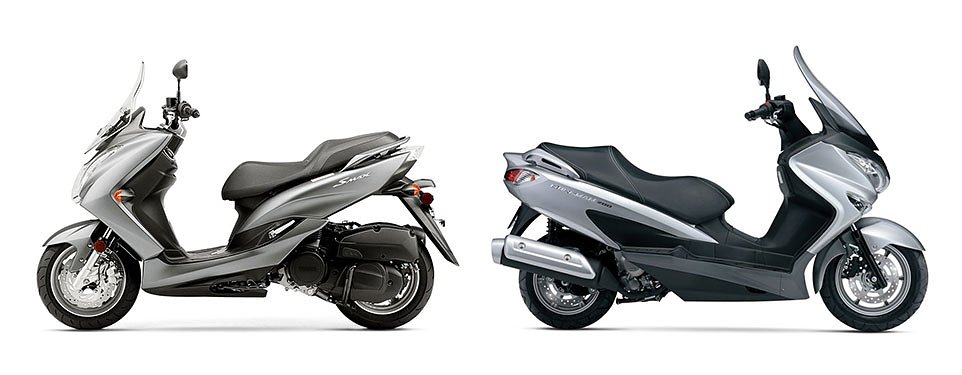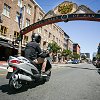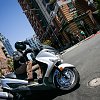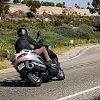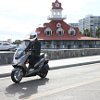Mini maxi? Is that a thing?
OK, so maybe I just made it up. But what else do you call scooters that resemble the maxi scooters (better wind protection, freeway-capable, etc.) but are mini in size? Suzuki and Yamaha have released models that fit into this market niche I just labeled, so let's just go with it.
The bikes

The 2014 Suzuki Burgman is powered by a 200 cc single-cylinder, liquid-cooled and fuel-injected engine which makes 18 horsepower. It rolls on a 13-inch front tire and 12-inch rear, and has a wheelbase of 57.7 inches.
The Burgman has a wet weight of 359 pounds and a 28.9-inch seat height. Underseat storage is rated at 10.8 gallons, enough to hold two full-face helmets, and it has another 1.5 gallons of storage between the two smaller front bins, one of which is lockable. The lockable storage also has a 12-volt outlet for charging cell phones and other electronic devices.
The fairly small 2.8-gallon tank sits low, which helps keep the Burgman feeling mini.
Front suspension is handled by a conventional 33 mm fork, while the rear is a pair pre-load-adjustable shocks. Stopping power is provided by single discs at the front and rear, which also get the same Nissin ABS control unit Suzuki used on the Hayabusa.
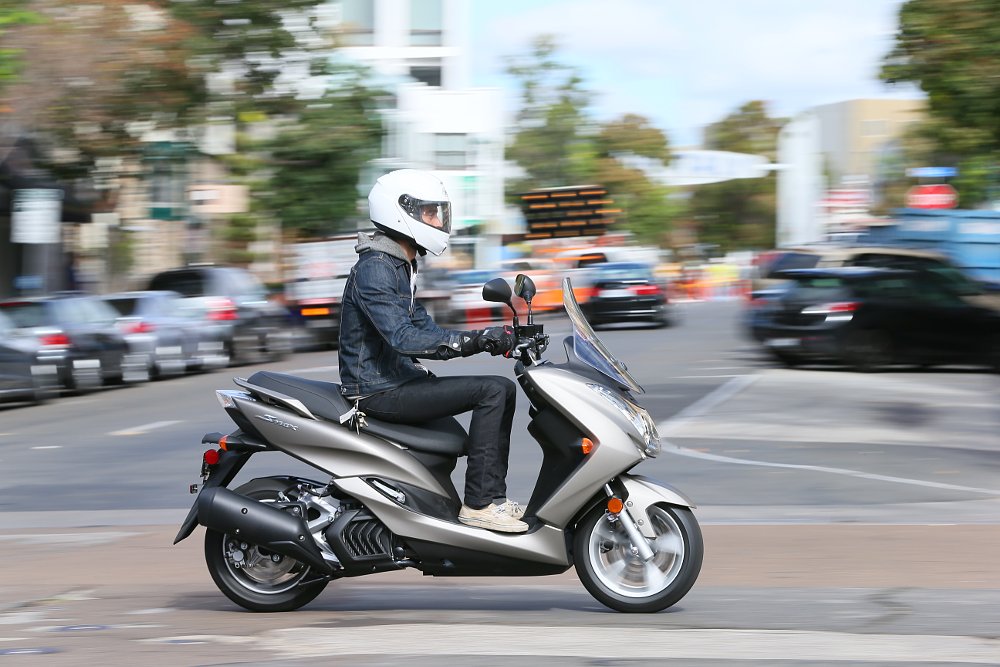
The 2015 Yamaha SMAX is a 155 cc single pot which puts down 14 horsepower. It, too, is both liquid-cooled and fuel-injected, and is paired with an automatic clutch and continuously variable transmission (CVT) to eliminate shifting. Yamaha claims fuel economy at 81 miles per gallon, which isn't half bad for a scooter that, by being larger than 150 cc, is freeway-legal.
Yamaha felt its biggest competition was the Honda PCX150, and took a number of steps to try to improve upon Honda's little scoot. The frame is all new, with a step-through design that makes getting off and on the scooter easier and leaves room for an aftermarket storage bag that fits between the rider's legs. The instrument panel is also all new and actually looks like one from a real motorcycle. It includes a digital speedometer, analog tach, clock, trip meters, warning lights, and even a gas gauge.
Yamaha really tried to think the SMAX through and consider what people used scooters for. Their polling told them 34 percent of scooter riders used their scoots for getting to and from work, while another 16 percent used theirs for running errands around town. This information guided many of Yamaha's decisions on the SMAX, from the rear shock, which is mounted horizontally to get out of the way of the 8.5-gallon under-seat storage area, to the flip-down hook and large storage compartment below the handlebars.
Yamaha is serious about freeway capability, too. The SMAX rolls on 13-inch wheels front and back, and on Kenda tires that were specifically designed to provide a larger contact patch and provide more stability at higher speeds. The 120/70-13 front and 130/70-13 rear should offer a more confidence-inspiring ride than the 90/90-14 front and 100/90-14 rear tires on the Honda.
The SMAX also has a 267 mm wave-type disc brake up front and a 245 mm disc in back, another area where Yamaha aimed to outdo the Honda's 220 mm front disc and rear drum brake.
The rides
If it seems odd that I'm comparing the Yamaha and the Suzuki, instead of the Yamaha and the Honda, consider this: The Yamaha pretty much eats the Honda's lunch while the Yamaha and Suzuki actually make an interesting comparison, because they're slightly different takes on this new mini-maxi scooter segment (yes, the one I just made up).

Also, both Yamaha and Suzuki held their press launches in San Diego, with the ride consisting of almost all of the same areas and riding conditions. I didn't show up to the Yamaha launch last week intending to compare the two, but when you find yourself on the same roads in the same conditions — it's hard not to spend the day making those mental comparisons.
Both scooters are touted as freeway-capable. The extra horsepower on the Suzuki really stood out during the freeway stint on both bikes, and I felt far more comfortable cruising at 80 mph or so and moving through traffic. I may have even seen speeds into the mid 90s, but I promise that was totally an accident. The Yamaha, on the other hand, maxxed out around the high 70s, although I was able to hit 84 mph during a downhill section on the freeway while drafting. The difference is that while both bikes will run with the pack, the Burgman made me feel like I had as much right to be out there as any car, while on the Yamaha, I felt like I was excited to be let into the club.
Around town both the Burgman and SMAX are very competent little machines. Both handle admirably and felt both extremely maneuverable yet completely stable. Both bikes use similar 33 mm front forks, but the adjustable twin shocks at the back of the Burgman soaked up road bumps much better than the SMAX's single shock. I wouldn't be doing my job as an evaluator if I didn't attempt to drag some hard parts on both, which I was able to do on the SMAX fairly easily, but the Burgman allowed much more lean angle and seemed to prefer I drag a knee or elbow before scratching its hard bits.
The good
While the Yamaha SMAX is a budget, entry-level scooter, it does not look like one. While the styling isn't the best for catching the eye of that cutie at the café, Yamaha didn't use the price as an excuse not to give you your money's worth. The instrument panel gives you far more information than you would expect, with an aesthetic that looks beautiful and mature. LED lights are a nice touch, as are the press-to-release passenger footpegs that snap out when depressed. Earlier this year, I bemoaned brands not paying attention to the finishing touches on a bike, and the Yamaha SMAX is a beautiful example of a company acting like it cares about the products that carry the brand.

Spending time on the Burgman 200 had me wondering if there was really any point to the Burgman 400. The 200 really is that good. Where other scooters still leave you with that "I just need a little bit more power" feeling, the Burgman has enough for everything you might need to do. You can cruise and even pass people on the freeway, enjoy the twisties, and use it for daily commuting or grocery shopping.
The bad
Fuel economy on the Burgman was in the 60 mpg range during our press ride. Not that 60 mpg is bad, but compared to other machines that get 80 to 100 mpg and are still freeway-capable, it isn't the best.

At just over six feet tall, I found the SMAX to be pretty cramped. Most scooters have a flat foot area and a floorboard that is angled upwards into the front fairing, but the angle on the SMAX was too steep to use comfortably. The Burgman, on the other hand, felt much better ergonomically.
Neither scooter is going to win any beauty pageants, but the Burgman is a particularly silly looking thing. It looks much more like someone shrunk a maxi scooter to make it more around-town capable, whereas the SMAX looks like someone beefed up a normal scooter.
The CVT used in the Yamaha SMAX felt a little clunkier and had more lag while switching gears than the Burgman's. At times, it would stay in a gear for too long or downshift awkwardly, which made for not the smoothest of rides. It's hard to expect too much more from a scooter at this price point, but the transmission in the Burgman felt noticeably nicer.
Which one should I buy?
This is a really tough question. The Yamaha SMAX has an MSRP of $3,690, while the Suzuki Burgman 200 will run you $4,999.

If you're one to look at just the numbers and which is a better bargain, I would say the Yamaha SMAX is the scoot for you. It will do the freeway, and do so safely. If you rarely need to get on the highway or only need to for brief stints, you really can't do better for the money.
For my money, however, I would buy the Burgman 200. I preferred how much better it ate up road bumps and those few extra ponies were really noticeable, which would be important for my frequent rides on the freeway or down the six-lane Pacific Coast Highway. Plus, having ABS is huge.
Have you considered a scooter in the mini-maxi segment? Which one is the most appealing to you?




